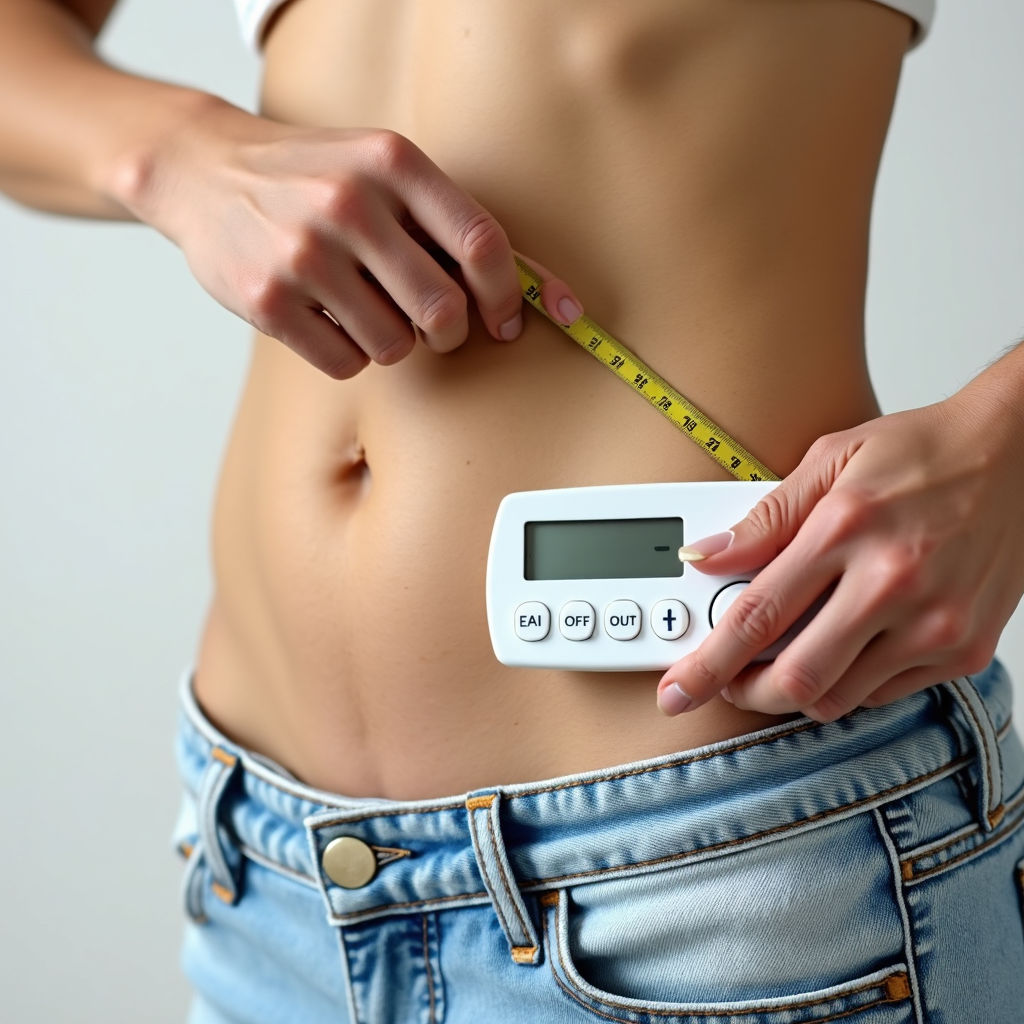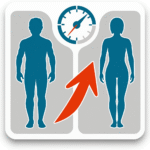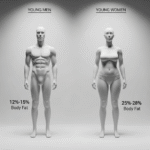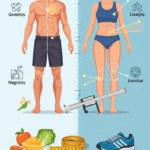Body fat calc: Your guide to evaluating health! Learn about measurement techniques, gender norms, and how to maintain a healthy body fat percentage.
Body Fat Calculator
What Our Users Say
Table of Contents
Understanding body fat is essential for evaluating overall health and fitness. This comprehensive guide covers body fat’s importance, techniques for measuring body fat percentage, and the implications of BMI limitations. Discover various methods for assessing body composition, including skinfold calipers and the Navy Body Fat Calculator, and learn how gender differences affect body fat norms. Achieving and maintaining a healthy body fat percentage is vital for preventing chronic diseases and promoting longevity. With this information, you can set tailored fitness and nutrition goals to enhance your overall well-being.

Body Fat Calc and Its Importance
Body fat, often referred to as adipose tissue, is a vital component of human anatomy and physiology. It serves several essential functions in the body, including energy storage, insulation, and protection of internal organs. Understanding body fat is critical for evaluating overall health and fitness, as it plays a pivotal role in body composition and metabolic health.
Body composition is a term that describes the proportions of fat, bone, water, and muscle in an individual. A certain percentage of body fat is necessary for good health; it helps to cushion and protect the organs and contributes to the body’s energy reserves. However, an excessive accumulation of body fat can lead to various health issues, including obesity, cardiovascular diseases, diabetes, and other metabolic dysfunctions. Thus, maintaining an optimal level of body fat is crucial for preventing chronic diseases and promoting longevity.
Moreover, body fat significantly influences athletic performance. Athletes often work to achieve specific body fat percentages to enhance their performance and achieve ideal body composition for their respective sports. For instance, in endurance sports, a lower body fat percentage can lead to improved speed and efficiency, while certain strength-based sports may benefit from a slightly higher level of body fat to support muscle strength and power output. Therefore, understanding body fat is not only essential for health but also for achieving peak athletic performance.
Considering the importance of body fat, various methods have been developed to measure body fat percentage accurately. In the subsequent sections, we will explore these methods in detail, highlighting their effectiveness and relevance to individuals seeking to assess their body composition and overall health status.
What is Body Fat Percentage?
Body fat percentage is a crucial metric that quantifies the proportion of fat in an individual’s body relative to their total weight. This measurement is significant because it goes beyond mere weight, reflecting not only the amount of essential and stored fat but also providing insights into an individual’s health status. Understanding body fat percentage can guide individuals in managing their health and fitness goals.
There are two primary categories of body fat: essential fat and stored fat. Essential fat is the minimal amount of fat necessary for proper physiological functioning, playing key roles in hormone production, nutrient absorption, and overall metabolic processes. For men, essential fat typically accounts for about 2-5% of total body weight, whereas, for women, this figure ranges from 10-13%, reflecting their unique biological requirements.
In contrast, stored fat refers to the fat that accumulates in the body, serving as an energy reserve. This type of fat can be beneficial in moderation, but excessive amounts can lead to various health issues, including cardiovascular diseases, diabetes, and metabolic disorders. Healthy body fat percentages are generally seen as those between 10-20% for men and 20-30% for women. Maintaining body fat within these ranges supports optimal health and reduces the risk of chronic illnesses associated with both high and low body fat levels.
It is essential to recognize that both high and low body fat percentages carry health risks. High body fat, particularly visceral fat around the abdomen, is associated with increased risk of heart disease and other health complications. Conversely, extremely low body fat percentage can lead to hormonal imbalances, weakened immune function, and nutritional deficiencies. Therefore, achieving and maintaining a healthy body fat percentage is vital for overall wellness and longevity.
The Role of BMI in Body Fat Assessment
Body Mass Index (BMI) is a widely used tool for assessing body fat and is often employed in public health contexts to categorize individuals based on their weight relative to height. The formula for calculating BMI is straightforward: a person’s weight in kilograms is divided by the square of their height in meters (kg/m²). This calculation yields a numerical value that can categorize individuals as underweight, normal weight, overweight, or obese, based on standardized ranges. Despite its simplicity and ease of use, BMI has limitations that should be acknowledged, particularly when considering its application in assessing body fat percentage.
One significant limitation of BMI is that it does not directly measure body fat; rather, it provides an indirect estimation based on weight and height. This can lead to misleading conclusions, especially for athletes and individuals with a higher muscle mass, who may have a BMI that categorizes them as overweight or even obese, despite having a low body fat percentage. Muscle weighs more than fat, and since BMI does not differentiate between fat and lean body mass, it can misrepresent the actual body composition of an individual.
Moreover, BMI does not take into account the distribution of body fat, which can be an important factor for assessing health risks. For instance, individuals with similar BMI values may have differing levels of visceral fat, which is associated with increased health risks. Therefore, while BMI can serve as a useful starting point for assessing body fat, it should not be wholly relied upon as the sole method. Complementary assessments, including measurements of body fat percentage using methods such as skinfold calipers, bioelectrical impedance analysis, or dual-energy X-ray absorptiometry (DXA), can provide a more comprehensive understanding of an individual’s body composition.
Various Body Fat Calculation Methods

Calculating body fat percentage is an essential aspect of maintaining overall health and fitness. There are several methods available for individuals seeking to assess their body fat levels, each with its unique advantages and limitations. This section provides an overview of some common approaches, encompassing the body fat calculator (kg) and the use of calipers.
One of the most accessible methods is the body fat calculator (kg), which typically requires input of basic metrics such as weight, height, age, and sex. These calculators use specific formulas to estimate body fat percentage. While they offer convenience and immediacy, their reliance on general population data can lead to inaccuracies, especially in individuals with atypical body compositions or those who engage in significant physical training. Thus, while body fat calculators can serve as a quick estimation tool, they may not represent one’s true body fat percentage.
Another widely used method involves skinfold thickness measurements, obtained through the use of calipers. This technique entails pinching the skin at specific sites on the body and measuring the thickness of the subcutaneous fat. Skinfold measurements can provide a more tailored estimate of body fat percentage, as they reflect the individual’s unique distribution of fat. However, accuracy heavily relies on the skill of the technician performing the measurement and the quality of the calipers used. Furthermore, this method can yield varying results based on the individual’s level of hydration and activity prior to testing.
In summary, while both the body fat calculator (kg) and caliper methods have their benefits, they also present limitations that should be considered when assessing body composition. Understanding these diverse approaches empowers individuals to make informed choices regarding their health and fitness evaluations.
Detailed Look at Caliper Measurements
Caliper measurements are a widely used method for assessing body fat percentage, primarily through the evaluation of skinfold thickness at specific sites on the body. This technique employs skinfold calipers, which are specialized devices designed to pinch the skin and underlying fat, allowing for precise measurement. The fundamental principle behind this approach is that, beneath the skin, a layer of subcutaneous fat exists, which can be quantitatively assessed to estimate overall body fat.
The most common measurement sites for skinfold testing include the triceps, abdomen, thigh, suprailiac (just above the hip bone), and subscapular (beneath the shoulder blade). By taking measurements from these sites, practitioners can calculate total body fat through established equations that take into account the individual’s gender and age. Generally, measurements are taken three times at each site to ensure accuracy, and the average is used for calculations.
Interpreting the results from caliper measurements requires an understanding of body fat percentage norms. For men, a body fat percentage of 6-24% is often considered healthy, while for women, this range is typically 16-30%. It is worth noting that factors such as hydration levels, time of day, and technique consistency can influence the results, thus affecting their reliability.
When comparing caliper measurements to other methods such as bioelectrical impedance or hydrostatic weighing, calipers are generally viewed as less expensive and more accessible for individuals or trainers. However, while calipers can yield reasonably accurate results, they do require training to ensure consistency in measurement techniques. This method can be especially beneficial for fitness enthusiasts, personal trainers, or clinicians who seek to track body fat changes over time and monitor health improvements effectively.
Body Fat Percentage Charts: Understanding Your Results
Body fat percentage is a crucial metric that reflects the amount of fat in your body compared to other components like muscle and bone. To effectively interpret these figures, utilizing body fat percentage charts can provide clarity on where an individual falls within various categories of health. These charts often categorize body fat percentages into ranges for men and women, thus allowing for a tailored approach to health and fitness goals.
For men, a healthy body fat percentage typically ranges between 10-20%. Those who fall within this range are generally considered to maintain a healthy weight. As the body fat percentage climbs beyond 20%, the categories shift to overweight (21-24%) and then to obese (25% and higher). Women, on the other hand, have slightly different ranges due to biological differences in body composition. A healthy body fat percentage for women ranges from 18-28%; overweight is classified as 29-32%, and obesity begins at 33%.
When interpreting these charts, one must consider that individual factors such as age, genetics, and activity level can significantly affect body fat distribution. While charts provide a useful guideline, they should not be the sole determinant of health. It is advisable for individuals to combine the information from these charts with other health metrics and assessments. This holistic approach allows for a more comprehensive understanding of body composition, fostering realistic and achievable health and fitness objectives.
Overall, body fat percentage charts serve as a valuable resource in evaluating personal health. By understanding the categories of healthy, overweight, and obese based on body fat percentages, individuals can set informed fitness goals and utilize strategies for improvement. This will not only enhance overall physical well-being but also contribute to a balanced lifestyle.
The Navy Body Fat Calculator Explained

The Navy Body Fat Calculator is a widely recognized method used to estimate an individual’s body fat percentage. This calculator is particularly valuable because it relies on simple circumference measurements taken at specific points on the body. The methodology behind this tool is founded on the relationship between measurements such as the neck, waist, and hips to estimate body fat. It is designed to offer a relatively accurate estimation by incorporating these key body dimensions into its calculations.
To utilize the Navy Body Fat Calculator, one needs to obtain a few essential measurements. First, for males, measure the circumference of the neck just below the Adam’s apple, as well as the waist at the navel level. For females, the neck measurement remains the same, but waist measurement is taken at the smallest point. Additionally, females are required to measure their hip circumference at the widest part. Once these measurements are collected, they can be plugged into the formula specified by the Navy method, yielding an estimated body fat percentage.
In comparison to other methods of body fat assessment, such as skinfold calipers or bioelectrical impedance analysis, the Navy Body Fat Calculator presents a non-invasive, cost-effective option. While some may argue that methods involving direct measurement of fat tend to be more precise, the circumference-based approach offers a sufficient degree of accuracy for many individuals. It allows users to obtain a rough estimate of body fat, making it a practical choice for anyone seeking to monitor their body composition. Overall, whether for personal health goals or fitness tracking, the Navy Body Fat Calculator is a useful tool that supports informed decision-making regarding body fat levels.
Gender Differences in Body Fat Percentage
Understanding body fat percentage is crucial for assessing health and fitness levels, but it is equally important to recognize the biological and physiological differences that exist between genders. These differences significantly influence body fat distribution, composition, and recommended body fat percentages.
Generally, women tend to have a higher body fat percentage than men. This discrepancy is primarily due to hormonal differences, particularly estrogen, which encourages fat storage. For instance, women are naturally predisposed to accumulate subcutaneous fat, especially in the hips, thighs, and breast areas, which serves important reproductive functions. In contrast, men typically have a greater proportion of visceral fat, which accumulates around the abdominal organs and is often associated with higher health risks. As such, average body fat percentage ranges are recommended to vary by gender, with healthy ranges for women generally falling between 20% to 35% and for men, 10% to 20%.
These differing body fat percentage norms reflect not only biological roles but also implications for health. Excess body fat, particularly visceral fat prevalent in men, can lead to cardiovascular diseases, diabetes, and other metabolic syndromes. On the other hand, both low and high body fat percentages in women can result in reproductive health issues and hormonal imbalances. Therefore, it is crucial to look at body fat percentage through a gender-specific lens when developing fitness programs or health guidelines aimed at improving overall well-being.
Furthermore, societal expectations and perceptions of body image often influence how individuals approach body fat. These perceptions can contribute to body dissatisfaction and unhealthy behaviors across both genders. As awareness continues to grow regarding these complexities, it is essential for health and fitness professionals to provide tailored guidance that considers these fundamental differences in body fat percentage norms and related health implications.
Conclusion: Finding Your Ideal Body Fat Percentage
Measuring body fat percentage accurately is crucial for understanding your overall health and fitness levels. Body fat percentage not only reflects how much of your body is composed of fat but also provides insights into potential health risks associated with being underweight, overweight, or obese. Different individuals may require varying levels of body fat for optimal health, making personalized assessments essential.
Identifying a healthy body fat percentage can guide your fitness and nutrition objectives. Generally, a body fat percentage range of 10-15% is considered healthy for men, while women may aim for 20-25%. However, factors such as age, activity level, and genetic predisposition can significantly influence these numbers. Therefore, rather than striving for a one-size-fits-all target, it is more beneficial to set realistic, achievable goals that align with your unique physical condition and lifestyle.
Additionally, understanding the methods used for calculating body fat percentage can also aid in obtaining a more accurate reading. Techniques such as dual-energy X-ray absorptiometry (DEXA), hydrostatic weighing, and skinfold measurements can provide diverse insights into one’s body composition. These methods vary in accessibility and accuracy, highlighting the importance of selecting an appropriate technique based on individual needs.
Ultimately, consulting a healthcare professional or a certified fitness expert is advisable when determining your ideal body fat percentage. They can provide tailored recommendations and help develop a comprehensive fitness and nutrition plan that aligns with your health goals. By emphasizing a balanced approach to body composition, you can cultivate a healthier lifestyle and improve overall well-being.









